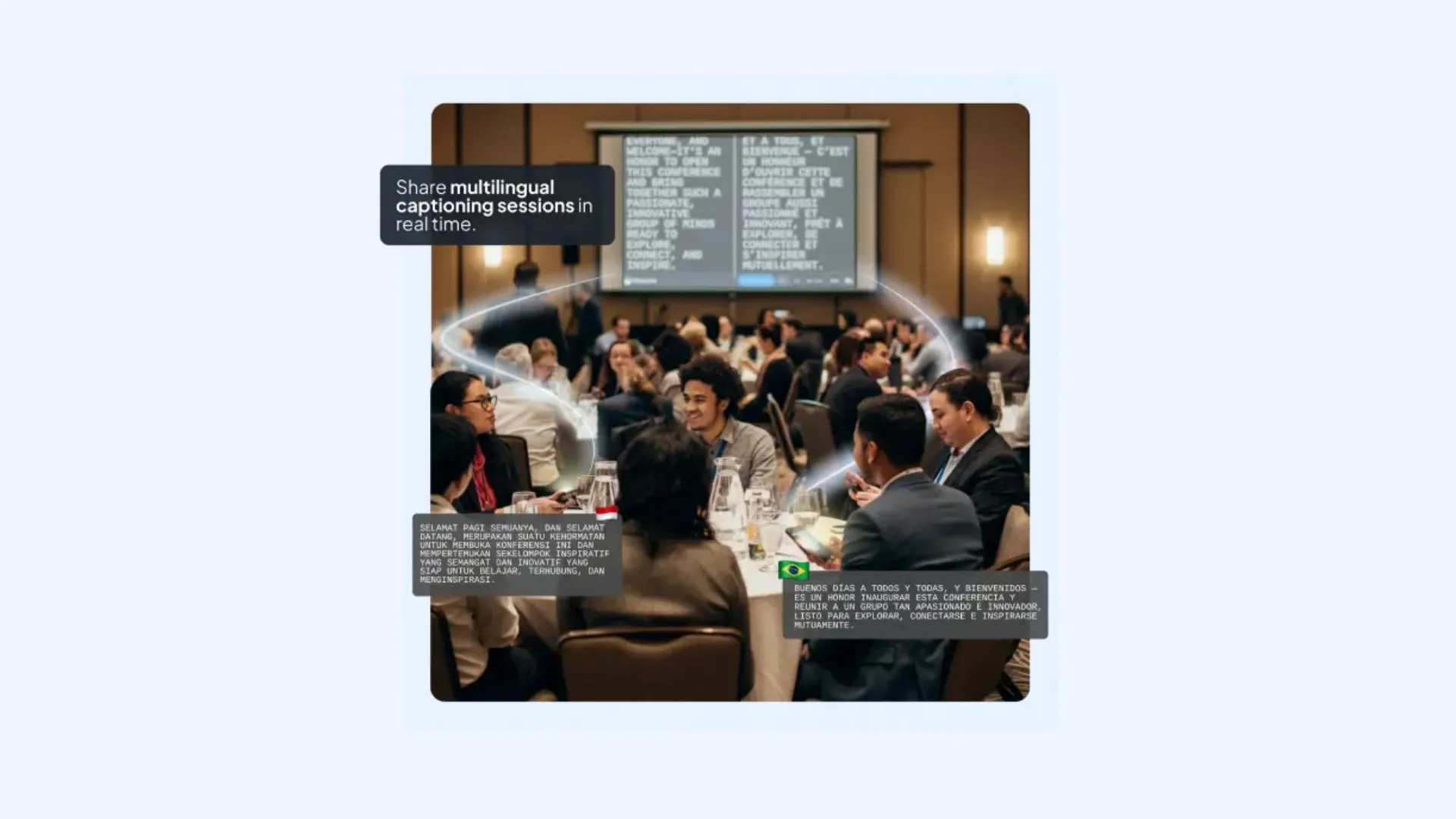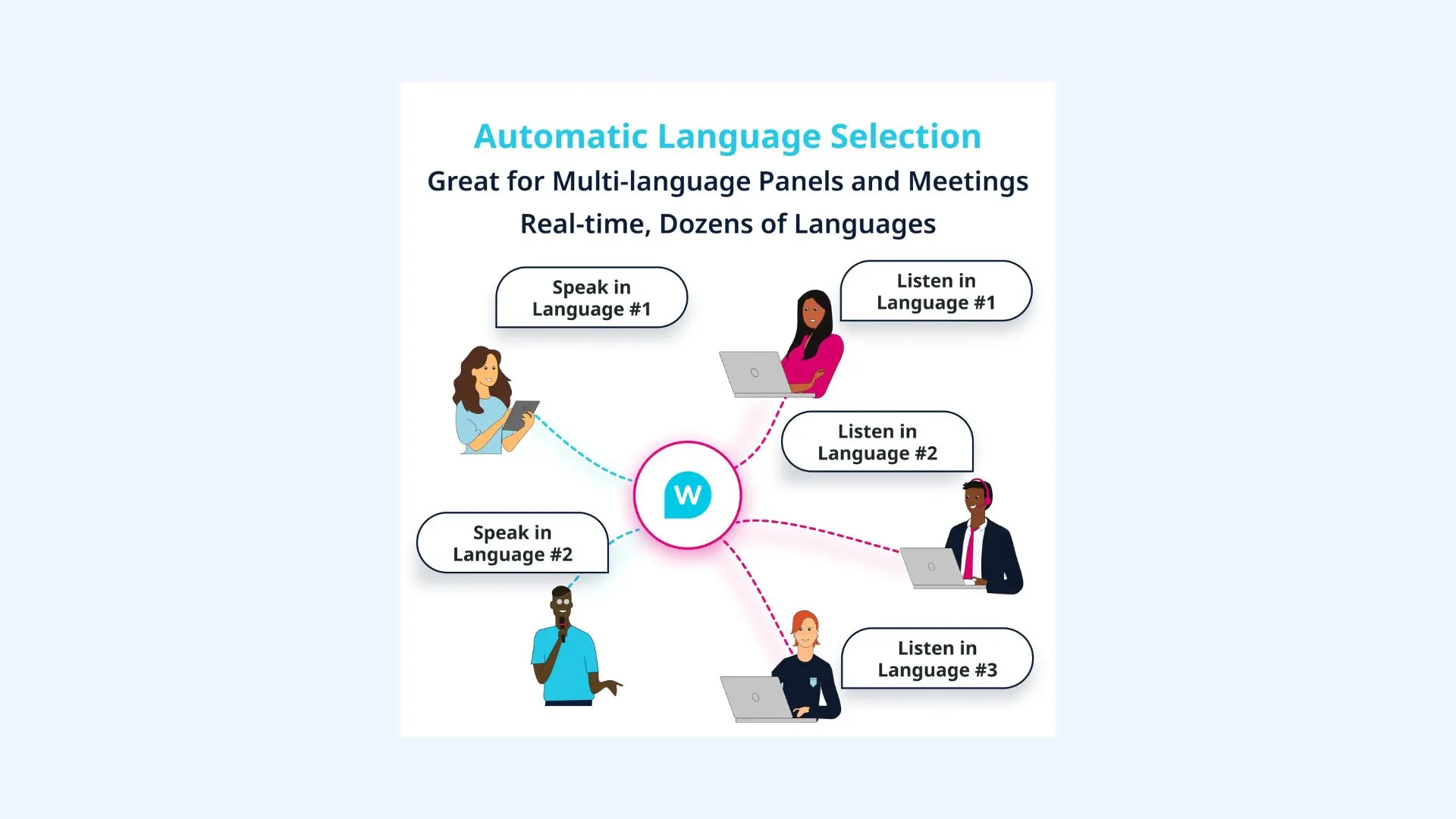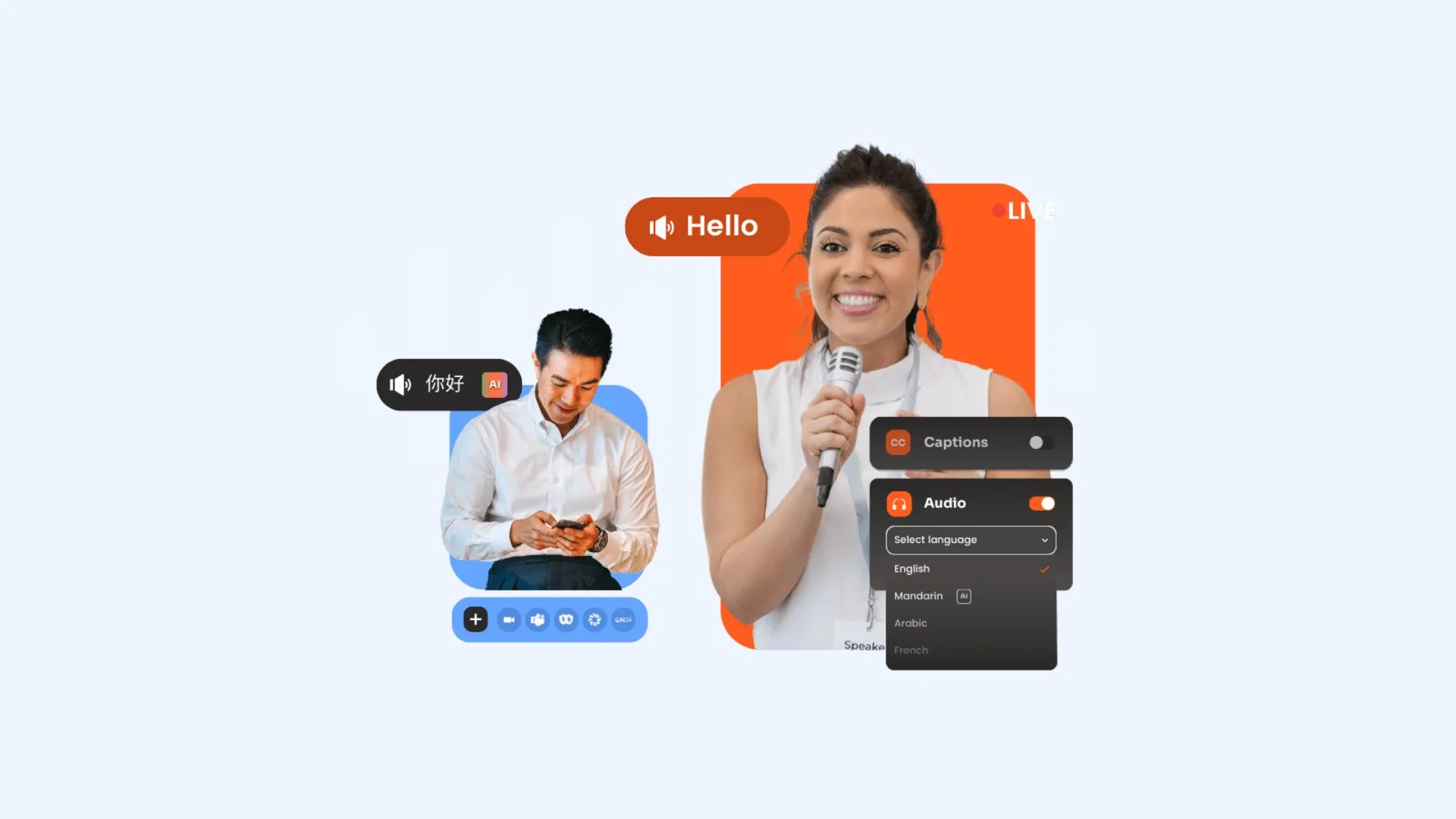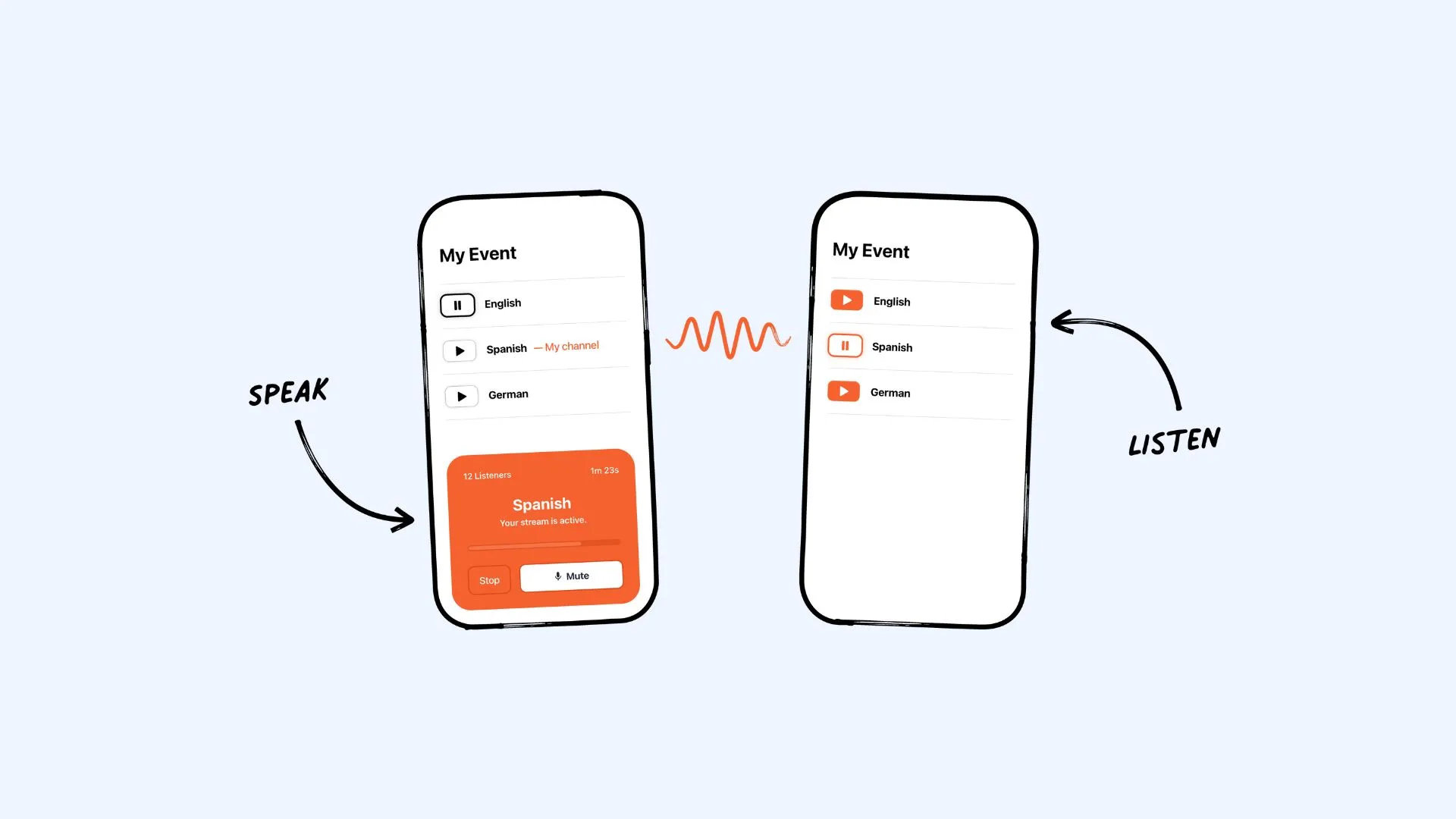5 Best KUDO Alternatives for Live Translation

KUDO is a popular choice for real-time translation and interpretation for multilingual meetings, webinars, and conferences, yet it's not the only one. Today's market is rich with innovative translation services that offer flexibility, specialized features, and scalable solutions tailored to different types of needs. From AI-powered software to interpreter-driven platforms, the tool you're looking for is right within your reach.
In this blog, we'll compare 5 best KUDO alternatives, breaking down their pros and cons. By exploring their features, pricing, and ideal use cases, this guide will help you confidently choose the perfect real-time translator for your next meeting, webinar, or global event.
Let's get started.
Top KUDO Alternatives in 2025
The table below compares 5 best KUDO AI alternatives available today. Each tool uses advanced speech recognition and translation technology to help individuals and organizations help overcome language barriers in real time.
| KUDO Alternative | Number of Supported Languages | Pricing |
| Maestra | 125+ | Free 10 minutes of live transcription; real-time voice translation starts at $79/month |
| Wordly | 60+ | Pricing based on package size (hours and attendees); custom quotes available |
| Interprefy | 80+ AI, 100+ with interpreters | Custom quotes based on interpreter hours, event size, and integrations |
| LiveVoice | 65+ | BASIC 10 plan is €7 per day or €21 per month, PRO 10 plan is €26 per day or €78 per month |
| Spf.io | 100+ | Subscription-based; customized quotes depending on usage and needs |
1. Maestra
Maestra is an AI-powered platform that makes live translation effortless. It instantly translates spoken audio and captions in real time, right in your browser. With support for over 125 languages, Maestra allows participants to hear voices translated in real time while also reading captions in both the original and translated languages, all without needing to download or install anything.
I'm particularly impressed by how Maestra's live voice translator delivers high accuracy and natural-sounding output. In my experience, the latency is low enough that participants can follow along smoothly, which makes it practical for meetings, webinars, and classrooms where timing matters just as much as accuracy.
Best for: Meetings, live events, webinars, and classrooms that need instant translation without complex setup.
Standout feature: Real-time voice cloning, which preserves the tone and style of the original speaker's voice.
Pros
- Multilingual meeting sessions where participants can choose their preferred language
- Easy audience access with just a link or QR code
- Simple, user-friendly interface
- Option to save recorded sessions, export in different formats, and summarize with AI
- Zoom, OBS, and vMix integrations
Cons
- Requires stable internet connection
- Limited cultural nuance compared to human interpreters
Pricing: Free 10 minutes of live transcription, four paid plans available to fit different usage needs.

2. Wordly
As one of the best KUDO alternatives, Wordly takes a fully AI-driven approach to live translation. What sets Wordly apart is its focus on scale. It was built with large meetings, conferences, and events in mind, where organizers need to support hundreds or even thousands of participants in multiple languages at once.
Wordly's biggest benefit is its simplicity. You don’t have to schedule or coordinate interpreters, and you can launch multilingual captions instantly across platforms like Zoom, Webex, and Microsoft Teams.
Best for: Associations, enterprises, and large-scale conferences.
Standout feature: Push-to-Talk mode for smooth multi-speaker translation in multilingual meetings.
Pros
- Live translated audio, captions, and transcripts for over 60 languages
- AI-generated summaries of meetings and events
- Wide range of integration options (Zoom, Webex, Teams, and more)
- Automatic language selection for seamless participation
- Customizable glossaries to improve translation accuracy
Cons
- Accuracy depends on audio quality and language pair
- Budget considerations for organizations running frequent, high-volume multilingual sessions
Pricing: Based on the size of the package (number of hours and attendees). You can contact Wordly directly to get a custom quote.

3. Interprefy
Interprefy is one of the leading remote simultaneous interpretation (RSI) platforms, designed to connect event organizers with professional interpreters for high-stakes meetings, conferences, and global events. Unlike AI-only platforms, Interprefy’s foundation is built around human interpretation, but it now also offers AI-powered speech translation and captions to enhance accessibility.
I found Interprefy's mobile app particularly useful when attending hybrid or in-person events. Instead of relying on bulky headsets, you can simply log into the app, select your preferred language, and instantly access translated audio or live captions.
Best for: High-stakes corporate, government, and large-scale global events that require the accuracy and nuance of human interpreters.
Standout feature: A comprehensive hybrid model that combines a global network of professional human interpreters with scalable AI-powered solutions.
Pros
- Access to a global pool of certified interpreters
- Cultural nuance for critical events
- Integrations with various platforms like Zoom and Microsoft Teams
- Full-service event support including interpreter coordination and technical setup
- Supports hundreds of languages and dialects for international coverage
Cons
- Setup complexity may not suit smaller or casual meetings
- Can be more expensive than purely AI-driven solutions
Pricing: Custom quotes based on interpreter hours, event size, and integration requirements.

4. LiveVoice
LiveVoice is a flexible KUDO alternative that’s increasingly used for AI-powered speech-to-speech translation and subtitles at events. Attendees just connect via their smartphone, scan a QR code, and choose their preferred language channel.
I appreciated how simple it was to join. Instead of downloading specialized equipment or apps, you can connect right from your browser or phone and immediately hear translations.
Best for: Guided tours, churches, and community gatherings that need affordable multilingual access without extra hardware.
Standout feature: Flexible channel setup, which allows organizers to create as many language channels as they need and stream translations directly to attendees’ devices.
Pros
- Bring your own device (BYOD) — attendees use their own smartphones and headsets
- Customizable live event page for branding
- Affordable, mobile-first setup without hardware costs
- Low learning curve
- Works equally well for in-person, hybrid, and virtual events
Cons
- Fewer advanced post-event features (like detailed transcripts or dubbing)
- Relies on stable internet for both hosts and participants
Pricing: Flexible event-based pricing, with packages tailored to event size and duration.

5. Spf.io
Spf.io is an accessibility-focused platform built for organizations that want captions, translations, and projection tools all in one place. It offers a “control center” for captions and translations that can be automated with AI or monitored by a human operator to ensure accuracy.
Spf.io's operator interface is what makes the platform unique. An event volunteer or staff member can supervise the captions in real time, correcting mistakes as they appear.
Best for: Churches, nonprofits, schools, and hybrid events that need multilingual captions with optional human oversight.
Standout feature: The versatile and unified display stream, which allows captions and translations to be projected onto screens in the room, embedded into live streams, or accessed on participant devices.
Pros
- Multilingual polls to engage audiences in their own language
- Multilingual strategy consulting for organizations
- Manuscript mode to upload a pre-written script and release captions and translations line-by-line
- Projector view to display captions in up to four languages simultaneously on a TV or projector
- Embedded audience view to place captions directly in a website or live stream
Cons
- Accuracy depends on human oversight for best results
- Requires more setup than simpler solutions like LiveVoice
Pricing: Customized quotes based on specific needs.

How to Use Real-Time Translators: Best Practices
Choosing the right KUDO alternative is only the first step. Here are some actionable tips to follow to get the most out of live translation tools:
- Test your setup in advance. Run a quick trial to test audio clarity, caption speed, and device compatibility before the event.
- Prioritize audio quality. Use high-quality microphones, reduce background noise, and encourage steady speaking for better accuracy.
- Provide a glossary of terms. Upload key terms, names, and industry-specific vocabulary to improve translation consistency.
- Combine AI and human oversight when needed. For sensitive or high-stakes events, pair AI translation with human interpreters for maximum reliability.
- Share recordings and transcripts. Offer post-event materials in multiple languages to extend accessibility and provide lasting value.
Following these practices will help ensure your multilingual meetings and events run smoothly, boosting engagement and productivity no matter which KUDO alternative you choose.

Conclusion
To sum up, each KUDO alternative offers its own strengths:
🌍 Maestra – Best for meetings, webinars, and classrooms that need instant AI-powered voice and caption translation.
🏢 Wordly – Best for large-scale conferences and businesses needing multilingual captions.
🎤 Interprefy – Best for high-stakes corporate, government, and global events where professional interpreters ensure accuracy.
📱 LiveVoice – Best for guided tours, churches, and community gatherings with mobile-first access via QR codes.
🎬 Spf.io – Best for nonprofits, schools, and hybrid events needing accessibility-first features like captions, projection, and operator oversight.
Remember: real-time translation isn’t just about technology; it’s about creating events where everyone feels included. By selecting the right platform, you’ll give every voice a chance to be heard and every participant the chance to belong.
Frequently Asked Questions
What features should I look for in a KUDO alternative?
You should look for a platform with high accuracy and low latency to ensure a smooth real-time experience. Key features include support for multiple languages, seamless integrations with your existing platforms like Zoom or Teams, and a user-friendly interface. Finally, make sure the platform offers flexible pricing that fits your event size and frequency.
How do I decide between AI-only and human interpreter platforms?
Your choice depends on the event's needs. AI-only platforms like Wordly and Maestra are best for cost-effective alternatives for general meetings, webinars, and large conferences. In contrast, human interpreter-based platforms like Interprefy are ideal for high-stakes, sensitive, or legal events where cultural nuance and guaranteed accuracy are essential.
Do KUDO alternatives require special equipment?
Most KUDO alternatives do not require special equipment. Tools like Maestra and LiveVoice are browser-based or mobile-first, so anyone can join with just a link or QR code. However, for high-stakes events, professional audio equipment can improve accuracy and the overall experience.
How secure are these KUDO AI alternatives?
Most KUDO alternatives prioritize security by using encryption to protect both audio and text data. Many also comply with international standards like GDPR to safeguard user privacy. While security levels vary by provider, enterprise-grade platforms often offer the strongest protections.
Do these KUDO alternatives support sign language or accessibility for deaf or hard-of-hearing audiences?
These platforms typically support accessibility through live translations and captions rather than sign language. For example, Maestra and Wordly provide real-time captions that help deaf and hard-of-hearing participants follow along. Organizations that need sign language interpretation usually integrate human interpreters into the event setup.
